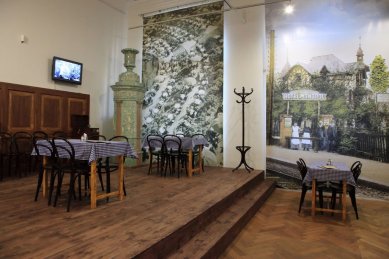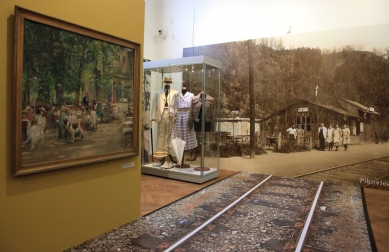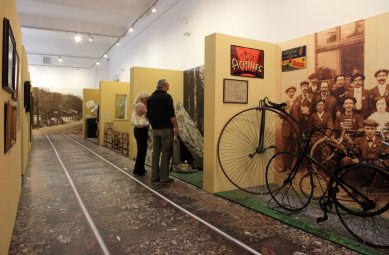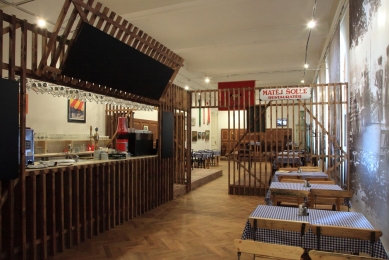
Exhibition of Prague Excursion Restaurants
"Green Huts" of Prague Residents in the Changes of the 19th and 20th Century
Prague residents, after hard work, you need rest, peace, and refreshment! Out of the stuffy Prague! To Povltaví and Posázaví for peace, refreshment, and health! Chuchle, Modřany, Zbraslav, Vrané, Měchenice, Davle, Štěchovice, Svatojánské currents, Slapy... You'll relax, refresh your body, calm your nerves, and strengthen your health. The beneficial climate of Povltaví and Posázaví will benefit all of you. Your bodies will tan to brown, your eyes will shine with satisfaction. Write to us when you plan to visit us. We will respond promptly to your inquiries.
This is how, at the end of the 1940s, restaurant owners attracted their guests, but even today, visitors to the Museum of the Capital City of Prague can be transported to the last century... The exhibition project, which will take place in two halls of the museum's main building, aims to comprehensively present to visitors the Prague excursion restaurants with their transformations in space and time: from places outside the Prague city walls in the nineteenth century, through "green havens" on the periphery, to renowned tramp and tourist inns around Prague in the twentieth century.
The exhibition will invite visitors on several excursions, where through photographs, postcards, films, and preserved items from restaurants, they will become acquainted with the excursion destinations of Prague residents at different times: to the Vltava islands, beyond the walls to Kravín, by electric train to Stromovka to "Šlechtovka." Other times by steamboat to Štěchovice and then on foot to the Rádio restaurant and from there on the Svatojánské currents on a giant raft back to the steamboat. Or by train - Posázavský pacifik with pinglíček and bendžem to Pikovice at the Starci, by car or train for the exotic distances to Roztok to the Sakura restaurant in Japanese style... and many other places with numerous refreshment possibilities.
Visitors in the exhibition will "take a trip" through time and space: from the second half of the nineteenth century through the first republic to the present day, from garden taverns in the city center to the forests of Central Bohemia and to the riverbanks.
As the author of the exhibition project, Tomáš Dvořák, also the author of the successful exhibition Prague Cafés and their World, says: “The journey will lead around large-scale photographs, preserved furnishings from private collections: these will be lent by the descendants of the owners of the Šlechtova restaurant in Stromovka, Zámeček in Letná, and the traditional and still functioning Slapská restaurant U Neužilů. Menus and drink lists, clothing, and outfitting for excursions will be displayed. Maps and plans from each time period will be prominently featured. To enliven the experience, excerpts from interwar and younger films will also be used. The exhibition will also offer the possibility of active viewing thanks to several playful interactive elements."
As part of the exhibition project, a corresponding publication will be created, sharing the same name, in which readers will be introduced to more than a hundred images of excursion restaurants accompanied by information about their origins and operations, memories of eyewitnesses, descendants of operators, and regular visitors to famous and ordinary places.
A functioning period restaurant will be part of the exhibition. Visitors-excursionists will be offered refreshments typical for the time when Prague residents, for example, set out for the scenic restaurant Terasy Barrandov for the music of R. A. Dvorský and his orchestra.
> www.muzeumprahy.cz/novinky/77-3
This is how, at the end of the 1940s, restaurant owners attracted their guests, but even today, visitors to the Museum of the Capital City of Prague can be transported to the last century... The exhibition project, which will take place in two halls of the museum's main building, aims to comprehensively present to visitors the Prague excursion restaurants with their transformations in space and time: from places outside the Prague city walls in the nineteenth century, through "green havens" on the periphery, to renowned tramp and tourist inns around Prague in the twentieth century.
The exhibition will invite visitors on several excursions, where through photographs, postcards, films, and preserved items from restaurants, they will become acquainted with the excursion destinations of Prague residents at different times: to the Vltava islands, beyond the walls to Kravín, by electric train to Stromovka to "Šlechtovka." Other times by steamboat to Štěchovice and then on foot to the Rádio restaurant and from there on the Svatojánské currents on a giant raft back to the steamboat. Or by train - Posázavský pacifik with pinglíček and bendžem to Pikovice at the Starci, by car or train for the exotic distances to Roztok to the Sakura restaurant in Japanese style... and many other places with numerous refreshment possibilities.
Visitors in the exhibition will "take a trip" through time and space: from the second half of the nineteenth century through the first republic to the present day, from garden taverns in the city center to the forests of Central Bohemia and to the riverbanks.
As the author of the exhibition project, Tomáš Dvořák, also the author of the successful exhibition Prague Cafés and their World, says: “The journey will lead around large-scale photographs, preserved furnishings from private collections: these will be lent by the descendants of the owners of the Šlechtova restaurant in Stromovka, Zámeček in Letná, and the traditional and still functioning Slapská restaurant U Neužilů. Menus and drink lists, clothing, and outfitting for excursions will be displayed. Maps and plans from each time period will be prominently featured. To enliven the experience, excerpts from interwar and younger films will also be used. The exhibition will also offer the possibility of active viewing thanks to several playful interactive elements."
As part of the exhibition project, a corresponding publication will be created, sharing the same name, in which readers will be introduced to more than a hundred images of excursion restaurants accompanied by information about their origins and operations, memories of eyewitnesses, descendants of operators, and regular visitors to famous and ordinary places.
A functioning period restaurant will be part of the exhibition. Visitors-excursionists will be offered refreshments typical for the time when Prague residents, for example, set out for the scenic restaurant Terasy Barrandov for the music of R. A. Dvorský and his orchestra.
> www.muzeumprahy.cz/novinky/77-3
The English translation is powered by AI tool. Switch to Czech to view the original text source.




0 comments
add comment











